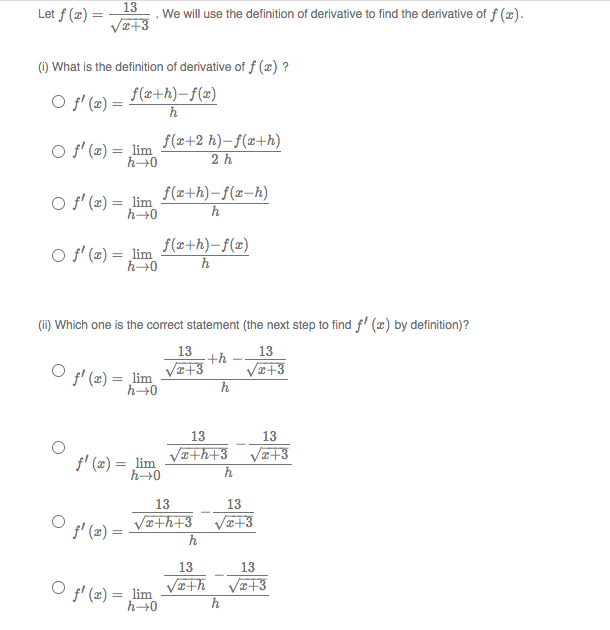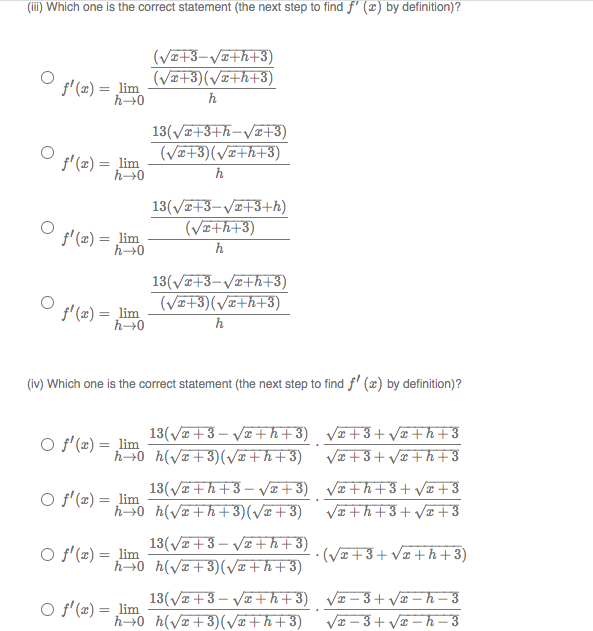Let f (z) = z+3 . We will use the definition of derivative to find the derivative of f (x). (1) What is the definition of derivative of f (2) ? O f' (2) = f(=+h)-f(2) O f' (z) = lim f(x+2 h)–f(x+h) h-0 2 h O f' (x) = lim f(x+h)-f(x-h) h O f' (x) = lim f(x+h)-f(x) h-0 (i) Which one is the correct statement (the next step to find f' (z) by definition)? 13 13 f' (2) = _lim +h Vzt3 h 13 Væ+h+3 h 13 Va+3 f' (x) = lim h→0 13 I+h+3 h 13 I+3 g' (z) = 13 13 Vath h O f' (z) = lim VI+3 h→0
Let f (z) = z+3 . We will use the definition of derivative to find the derivative of f (x). (1) What is the definition of derivative of f (2) ? O f' (2) = f(=+h)-f(2) O f' (z) = lim f(x+2 h)–f(x+h) h-0 2 h O f' (x) = lim f(x+h)-f(x-h) h O f' (x) = lim f(x+h)-f(x) h-0 (i) Which one is the correct statement (the next step to find f' (z) by definition)? 13 13 f' (2) = _lim +h Vzt3 h 13 Væ+h+3 h 13 Va+3 f' (x) = lim h→0 13 I+h+3 h 13 I+3 g' (z) = 13 13 Vath h O f' (z) = lim VI+3 h→0
Calculus: Early Transcendentals
8th Edition
ISBN:9781285741550
Author:James Stewart
Publisher:James Stewart
Chapter1: Functions And Models
Section: Chapter Questions
Problem 1RCC: (a) What is a function? What are its domain and range? (b) What is the graph of a function? (c) How...
Related questions
Question

Transcribed Image Text:13
Let f (2) =
Va+3
We will use the definition of derivative to find the derivative of f (x).
(1) What is the definition of derivative of f (x) ?
O f' (x) =
f(x+h)–f(x)
h
O f' (æ) = lim
f(x+2 h)– f(x+h)
2 h
f(x+h)-f(x-h)
O f' (x) = ,lim
h0
h
f(x+h)–f(x)
O f' (2) = lim
h0
h
(ii) Which one is the correct statement (the next step to find f' (æ) by definition)?
13
+h
Va+3
h
13
Va+3
f' (2) =
= lim
h0
13
13
Vath+3
h→0
Væ+3
f' (2) = lim
%3D
13
13
Vzth+3
VE+3
f' (z) =
13
13
Vzth
O f' (z) = lim
h→0
Va+3
h

Transcribed Image Text:(ii) Which one is the correct statement (the next step to find f' (¤) by definition)?
(Va+3-Va+h+3)
(Va+3)(V+h+3)
f' (2) = lim
h
13(Vz+3+h-Ve+3)
(Va+3)(VI+h+3)
f' (x) = lim
h
13(Va+3-Vz+3+h)
(VI+H+3)
f' (2) = lim
h→0
h
13(Vz+3-VE+h+3)
(Ve+3)(v¤+h+3)
f' (x) = lim
h→0
h
(iv) Which one is the correct statement (the next step to find f' (x) by definition)?
13(Va+3 – Va +h+3) Va+3+ ve +h+3
h→0 h(Va+3)(+h+3)
O f' (x) = lim
Væ +3+ Va +h+3
13(Va +h+3 – Va +3) Va + h+3+ væ+3
h→0 h(Va+h+3)(væ+3)
O f' (2) = lim
Va +h+3+V+ 3
13(Va+3 – Ve +h+3)
O f' (2) = lim
h→0 h(va+3)(VE +h+3)
(Vz+3+ Vr + h+3)
13(Va +3 – Ve +h+3) Væ - 3+ vz – h – 3
h-0 h(Vz+3)(/+h+3)
O f' (2) = lim
I- 3+ Va – h – 3
Expert Solution
This question has been solved!
Explore an expertly crafted, step-by-step solution for a thorough understanding of key concepts.
Step by step
Solved in 4 steps

Recommended textbooks for you

Calculus: Early Transcendentals
Calculus
ISBN:
9781285741550
Author:
James Stewart
Publisher:
Cengage Learning

Thomas' Calculus (14th Edition)
Calculus
ISBN:
9780134438986
Author:
Joel R. Hass, Christopher E. Heil, Maurice D. Weir
Publisher:
PEARSON

Calculus: Early Transcendentals (3rd Edition)
Calculus
ISBN:
9780134763644
Author:
William L. Briggs, Lyle Cochran, Bernard Gillett, Eric Schulz
Publisher:
PEARSON

Calculus: Early Transcendentals
Calculus
ISBN:
9781285741550
Author:
James Stewart
Publisher:
Cengage Learning

Thomas' Calculus (14th Edition)
Calculus
ISBN:
9780134438986
Author:
Joel R. Hass, Christopher E. Heil, Maurice D. Weir
Publisher:
PEARSON

Calculus: Early Transcendentals (3rd Edition)
Calculus
ISBN:
9780134763644
Author:
William L. Briggs, Lyle Cochran, Bernard Gillett, Eric Schulz
Publisher:
PEARSON

Calculus: Early Transcendentals
Calculus
ISBN:
9781319050740
Author:
Jon Rogawski, Colin Adams, Robert Franzosa
Publisher:
W. H. Freeman


Calculus: Early Transcendental Functions
Calculus
ISBN:
9781337552516
Author:
Ron Larson, Bruce H. Edwards
Publisher:
Cengage Learning